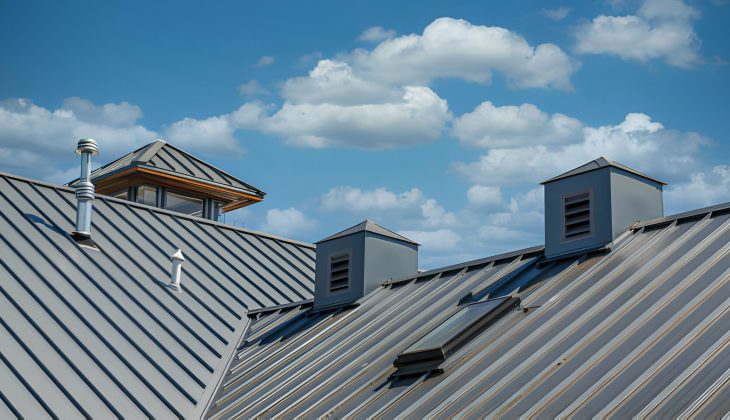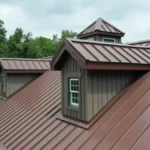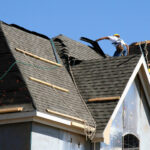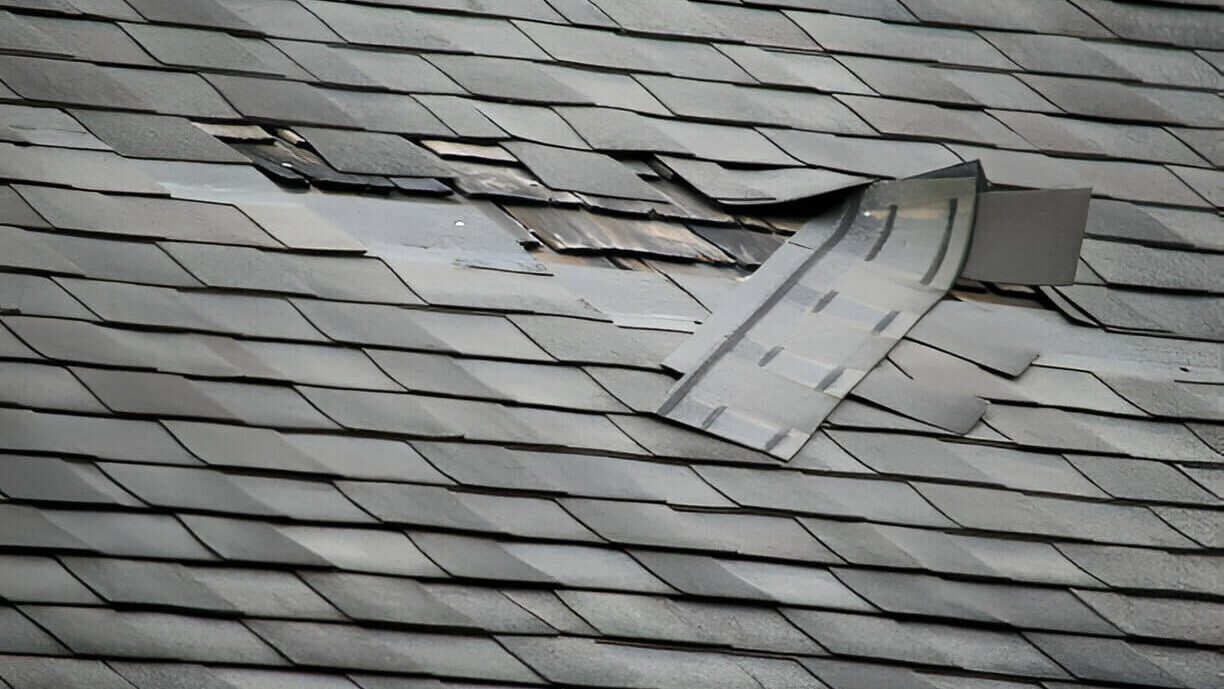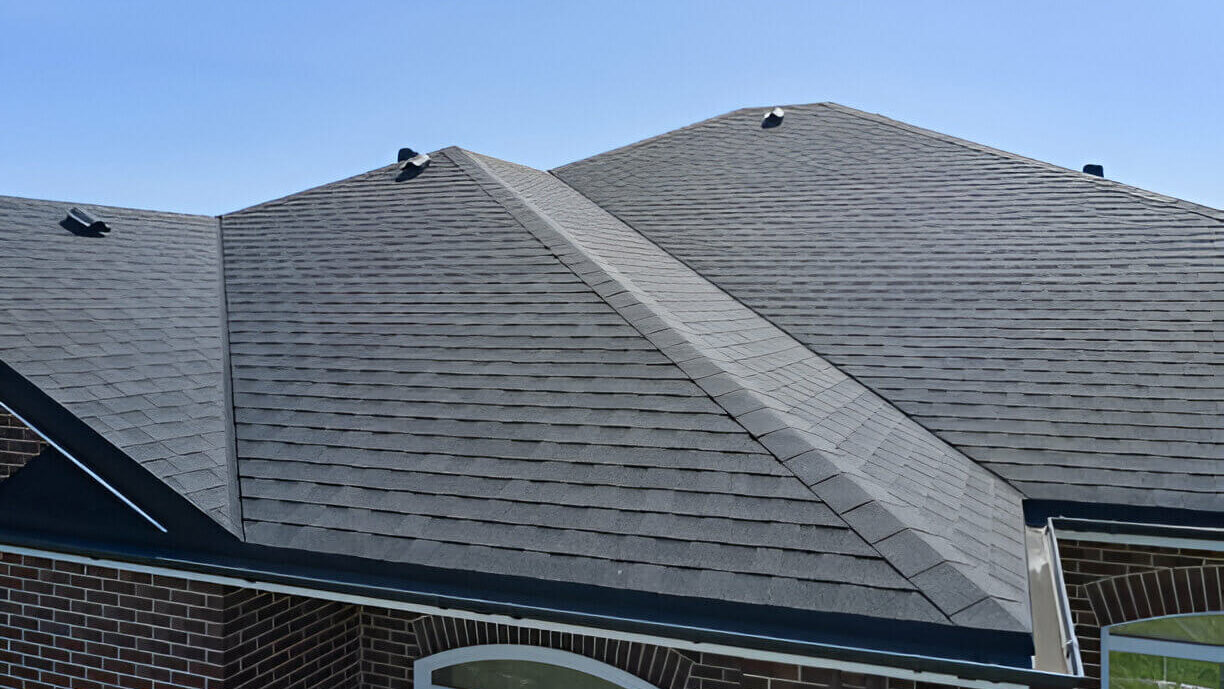Are you dreaming of a sleek, durable metal roof for your home? Hold on! Before you dip headfirst into shiny panels, there is a crucial detail to consider: the slope.
Table of Contents
ToggleMost metal roofs require a minimum slope of 3:12, which means that for every 12 horizontal inches, the roof rises 3 inches vertically. This translates to a 25% slope or 14.1-degree angle.
The minimum pitch for a metal roof depends on several factors, including the specific type of metal roof, design, and local building codes.
Do not go away! Read this blog and learn everything about the slope of a metal roof.
What Does Minimum Slope For A Metal Roof Mean?
The minimum slope for a metal roof is the steepest angle it can be installed at while functioning correctly and avoiding common issues like metal roof over shingles problems.
It ensures water efficiently sheds and does not pool, preventing leaks and damage. This angle is usually expressed as a ratio of the rise to run.
It is crucial to consider the specific type of metal roof, local codes, manufacturer recommendations, and your project’s unique needs to determine the appropriate slope for your situation.
Always consult a qualified roofing professional for expert advice based on your circumstances.
Minimum Slope For a Metal Roof
The minimum recommended slope for a metal roof is 3:12. For every 12 inches of horizontal distance, the roof should drop 3 inches vertically.
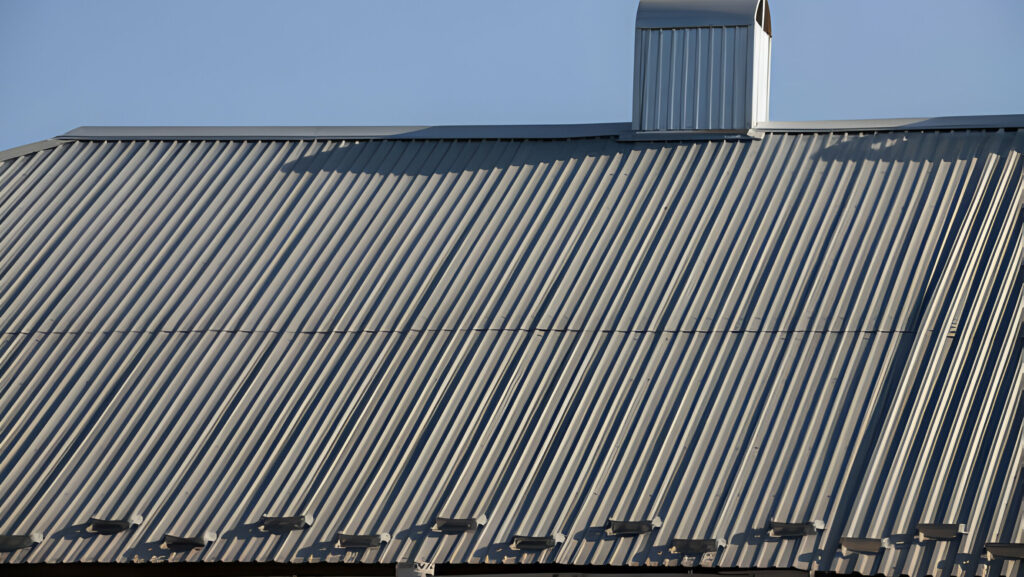
Such a slope ensures proper water drainage and prevents ponding, which can cause leaks in your roof.
The ideal slope for your lean-to-shed metal roof depends on different factors, such as metal panel type, local building codes, climate, shed purpose and size, manufacturer recommendations, and personal aesthetics.
| Metal Panel Type | Minimum Slope |
| Standing Seam | ¼: 12 |
| Corrugated | ½ : 12 |
| Shingles | 4:12 |
| Metal Tiles | 3;12 to 4:12 |
The International Building Code (IBC) specifies a minimum slope of 3:12 for lapped, non-soldered seam metal roofs without applied lap sealant. An applied lap sealant can reduce the minimum slope to 1/2:12.
Minimum Roof Slope For Standing Seam Metal Roof
Standing seam shines with durability, low maintenance, and sleekness but demands a steeper slope for optimal performance.
Standing seam metal roofs require a steeper minimum slope than lapped panels. According to the IBC, they need at least a 1/4 inch vertical rise per foot of horizontal span (1/4:12). However, local codes may be stricter, so always check with your building department first.
Minimum Slope For Corrugated Metal Roof
The required minimum slope for a corrugated metal roof is 1/2:12(half-inch rise for every foot of horizontal distance).
Due to its low slope, it is suitable for a wide range of applications compared to standing seam roofs.
Corrugated metal roofs offer durability and affordability, but remember: steeper slopes are essential for optimal drainage, especially in areas with heavy rain or snow.
Minimum Slope For R Panel Roof
R Panels offer a versatile and budget-friendly option for metal roofs, but their minimum slope should be considered.
Manufacturers recommend a minimum slope of 1:12(one-inch fall for every 12 inches horizontal distance) for R Panels.
The minimum slope for R Panels also depends on local building codes and climate.
Heavier snowfall and rainfall areas require a steeper slope of 3:12 for optimal drainage and snow shedding.
Minimum Roof Slope For Snow
In snow areas, metal roofs perform best with pitches of 3:12, 4:12, 5:12, or 6:12. Massive amounts of snow tend to tumble down the roof without warning at any pitch higher than 6:12.
A 1:12 slope is a severe mistake regarding snow-prone areas.
A 2:12 or 3:12 pitch may function sufficiently for standing seam metal roofs, which let snow slide off them effortlessly.
Minimum Slope For Roof Drainage
Roofs must contain a minimum slope to allow water to drain. Proper drainage prevents problems such as leaks, mold, or structural deterioration.
A minimum two percent slope, or one-quarter unit vertical for every twelve units horizontal, is required for roofs to facilitate drainage. This means that for every 12 inches, the roof must slope 1/4 of an inch.
It meets building codes in almost any roofing application.
Common Roof Slopes & Their Uses
Common slopes are low, conventional, and steep, ranging between 1/12 and 18/12.
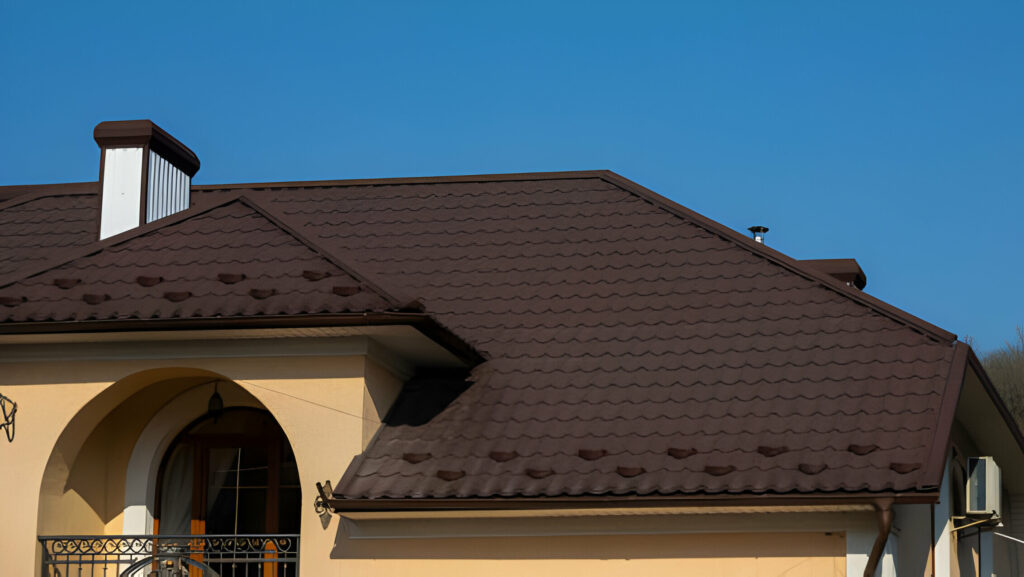
The most normal pitch is a conventional roof pitch, such as a 6/12, which is easy to install, fares well in most climates, and is aesthetically pleasing.
The lowest recommended slope for a metal roof is 3:12(3 inches fall for every 12 inches horizontal distance). It is not advisable to go below 3:12 as it increases the risk of leaks, especially in areas with heavy snowfall or frequent rainfall.
Low Slope – Best for Commercial Roofs
Low slopes are between 1/12 to 3/12, also known as flat roofs, which necessitate choosing a good roofing material for a flat roof.
They are cost-effective and offer additional usable space on rooftops. Low slopes are not ideal for heavy snowfall as water and snow might pool.
Limited snow shedding, potential ponding issues, and the need for a sound drainage system are the drawbacks of low-slope roofs.
They are used for commercial buildings, such as garages and sheds.
Conventional Slope – Best for Residential Roofs
Conventional slopes(3/12 to 6/12) are used for residential homes and ranch-style houses. They offer good balance for drainage, snow shedding, and aesthetics.
Conventional slopes are the most common for residential homes with asphalt shingles.
Examples are Gable, hip, and shed roofs. They might not be suitable for heavy snowfall as compared to steep slopes.
Steep Slope – Best for Victorian and Gothic Architecture
Steep-slopes range between 7/12 to 18/12. They are excellent in drainage and snow shedding.
Victorian houses, Gothic architecture, chalets, cabins, etc, are built with steep slopes. Gambrel, mansard, butterfly, and saltbox roofs are steep-pitched roofs.
They have higher construction costs and are at risk of potential wind uplift.
How to Calculate the Slope of a Metal Roof?
Calculating the slope of a metal roof is very easy and requires two measurements.
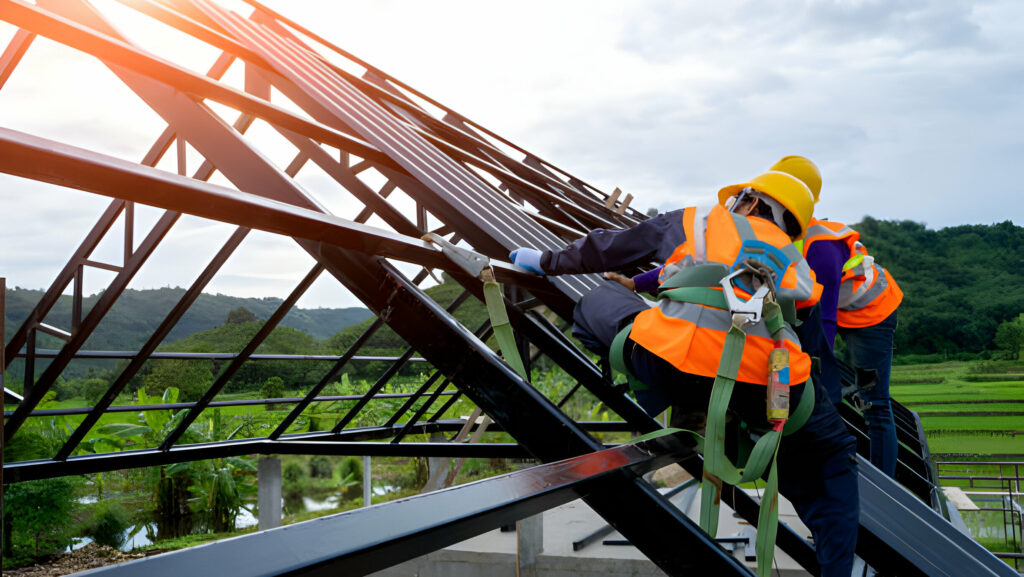
First, you need to measure the rise and run.
Rise: measure the vertical distance from the roof’s highest point to the lowest point directly below it.
Run: measure the horizontal distance between the two points you used for the rise measurement.
Then, divide the rise by the run.
The formula is Slope Rise/ Run.
You can express the slope in inches per foot as a ratio (e.g., 3:12) or as a percentage(e.g., 25%).
The slope of a metal roof can also be calculated using trigonometric functions. This method requires knowing the angle between the roof slope and the horizontal plane.
You can estimate it by using a protractor or an inclinometer app.
The formula is straightforward for this method.
Slope ratio: tan(angle)
Why is Slope in Metal Roofs important?
Metal roofs are known for their durability and longevity, but achieving this performance relies heavily on proper installation, and slope plays a crucial role in that equation. Slope is essential for:
- Efficient Water Drainage: The primary function of a roof is to shed water away from the building. Metal panels are smooth. A steeper slope allows water to flow quickly and efficiently, preventing ponding, which can lead to leaks, corrosion, and even structural damage.
- Weather Resistance: Metal roofs resist harsh weather, but a proper slope further enhances this protection. Steeper slopes shed snow and ice more effectively, preventing accumulation and the associated weight and stress on the roof.
- Aesthetics and Design: Slope is not just a functional necessity; it also plays an important role in the overall aesthetics of your building. Steeper slopes create a more dramatic and visually appealing profile, while low slopes offer a sleek, modern look.
- Maintenance and Safety: Steeper slopes are generally easier to access and maintain, allowing for safer and more efficient cleaning and repairs when needed.
Minimum Slope for a Metal Roof FAQs
Can metal roofing be used on a low-slope roof?
Metal roofing can be used on low-slope roofs, but not all types are suitable—generally, roofs with a pitch of 3:12 or steeper work well with most metal panels. Low-slope roofs (less than 3:12) need specific panels designed for low-pitch applications.
Do All Metal Roofs Have a Minimum Slope?
Yes, there is a minimum slope requirement for almost all metal roofs. This guarantees appropriate water drainage, avoids ponding, and eventually enhances the lifespan and functionality of the roof.
What Happens If the Slope Of My Metal Roof Is Too Low?
A metal roof with too low a slope can lead to ponding water, increased risk of leaks and corrosion, and reduced lifespan. Aim for a minimum slope of 3:12 for optimal drainage and performance.
Conclusion
Although metal roofs are remarkably durable, their installation and slope are crucial factors.
A minimum slope of 3:12 guarantees adequate water drainage, improved resistance to weather, and, eventually, a longer, healthier lifespan for the roof.
The benefits of metal roofing can be offset by skipping on the slope, resulting in leaks, stagnant water, and even structural problems.
Remember that your unique climate, design, and local regulations determine the ideal slope.

